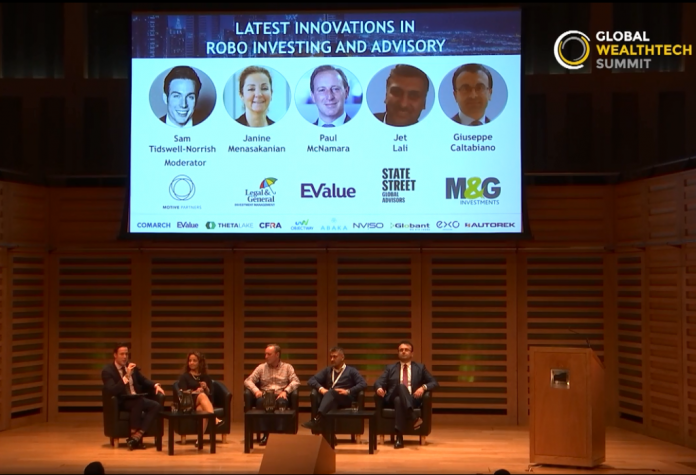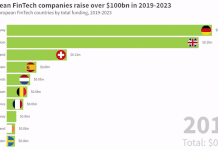Opportunities are rapidly increasing for robo-advisers, but the market needs an ‘awful lot more collaboration’, according to a panel at the Global WealthTech Summit 2018.
Interest in robo-advisers has been steadily increasing over recent years. Wealthfront closed a $75m in a funding round last year, and Moneyfarm also raised capital in 2018, netting £40m. It’s not just venture firms getting excited by the opportunities in the market, with various financial institutions either making investments in the space, or developing their own solutions. Santander is one of the most recent to deploy a solution, having launched it in the market at the end of last year.
The panel at the Global WealthTech Summit, which included senior staff from Motive Partners, Legal & General, EValue, State Street Global Advisors and M&G Investments, discussed the latest innovations in robo-investing and advisory.
One take-away from the panel was how much development has been made in the robo-advisory space, but this is still only the beginning. Data is becoming a lot more extensive and more widely available to market players. EU regulations like GDPR and PSD2 are also helping to provide consumers with more opportunities for personalised advice and stronger trust levels with institutions. However, EValue CEO Paul McNamara believes the current type of robo-advice is still only at the “the very, very early stages of finding propositions that really work for consumers.”
He went on to stress that while some markets have been satisfied and provided with great new tools, others have still been left rather dry. For example, a highly engaged investor that wants to move into stockbroking and have freedom to choose anything they want, are very well served. On the flip side, those more hesitant in investing or making large life decisions still need to use ‘expensive financial planning or utilise privileged relationships.
He added, “Technology has not yet come together, even though the cost of data, the cost of transmission, the cost of processing has collapsed. And we’ve not yet seen real breakthroughs that are getting into that middle market. And our people are not ultra-confident, or they are really needing handholding or very personalised recommendations without the distraction, without all of the noise that they otherwise need to cope with.”
However, human interactions mixed with robo-advice in a hybrid platform is becoming increasingly popular. It enables investors who are happy to just crack on and build a portfolio to do so with the robo adviser, but those which are more cautious can contact a human if they need and get their opinions. This is what some FinTechs like EValue are offering consumers, and could be the next stage for robos.
The evolution towards hybrid platforms was also supported by Jet Lali, Chief Digital Officer at State Street Global Advisors. He said, “In terms of the flavours of Robo advice, that’s kind of blending too. It started off with pure B to C type platforms and then evolved into hybrid platforms pioneered mostly by Vanguard, but now Nutmeg are now moving into that business as well.”
Partnerships
Choosing whether to partner, acquire or build a solution in-house is all a matter of opinion, with each institution having its own strategy. All routes have pros and cons, and an institution might do all three, it all depends on their DNA and how they operate best. However, the general opinion of the panel was the asset management and wealth management space needed to have more partnerships and collaborations between financial institutions and FinTechs. With Paul stating “we’ve got to see an awful lot more collaboration.”
M&G Investments head of D2C Giuseppe Caltabiano agreed that partnerships are key for the market, with Sandboxes, the cloud and new test and learning environments are helping to accelerate proof of concept and proof of value within FinTechs. One area he was particularly interested in is APIs.
He said “ API’s, which is a new standard for system interfaces in open banking and soon maybe open asset management, have the framework for new relationships. The great thing about API’s is that they are simple, universal mutual agreements between financial institutions so that they can be used simply and well, and they unlock new business models.”
Digital ecosystems are driven by interactions by various different players, and APIs are helping the network effects and boosting customer relationships across the network, he added. The other benefits of APIs is the marginal costs of participation towards another ecosystem, and the lower customer acquisition costs. As the market continues to evolve over coming years, Caltabiano believes more business models will become present, and offer different ways to engage with clients.
There are certain issues with partnerships that are presented to larger institutions. Their complex legacy systems and the various different strands of the business can make it difficult to support various different partnerships. Legal & General Investment Management head of distribution strategy, personal investing Janine Menasakanian went on to explain how a number of companies she’s interacted with told her they do not necessarily have the technology capability to integrate APIs with their tech stack. She added, “I think partnerships and definitely API’s, open source API is the way forward, but I don’t think it’s as easy to do as much as we’d like to right now.”
A lot of financial institutions are taking a more corporate venture route to the market. Barclays, Citi and Wells Fargo are just some of the institutions to establish their own accelerators, and each of these are doing very well in the market. This is a good alternative to partnerships, or can serve as a gateway into partnering. The institution can monitor the operations of a handful of companies, and if any are successful enough, or align with the running of the bank, then acquire them or establish a partnership.
State Street Global Chief Digital Officer Jet Lali had a conflicting opinion towards this system. While there have been many notable successes with accelerators, he feels that “nothing has really been a breakthrough success that’s really transformed the business yet.” He went on to explain acquiring a big technology company can be a good strategy, as there are long-term commitments to the strategy, but when buying a small company, it raises questions around just building it internally.
He added, “I think it’s a different type of proposition, but in either case you need to have a long-term commitment. It will work. But if you don’t have the stomach to kind of wait for five years of not making any money from it, it’s not going to work. And every time there is a new disruptive opportunity in the market, you have to be able to invest for five years. And I think the CEO’s that are confident enough in their own position to say, ‘okay, I can bet on this part of my business for five years,’ will win, nothing’s going to change in one or two years.”
Commenting on this viewpoint was Legal & General’s Janine who stated, “For large companies, what you don’t want to be, is sort of an outsource service sort of relationship manager. You want to get the right balance, and do some of it yourself, but also partner with the right tools as and where appropriate. And I think it’s getting that balance right though. It’s really quite tricky.”
Copyright © 2019 FinTech Global
Investors
The following investor(s) were tagged in this article.











